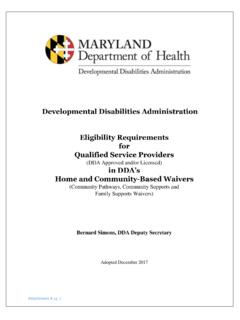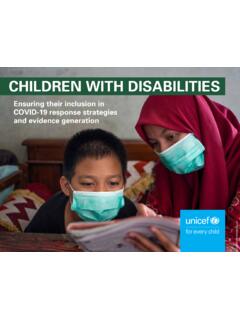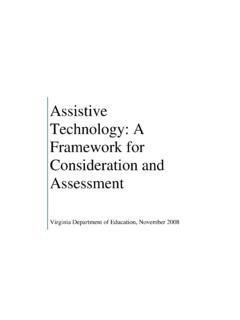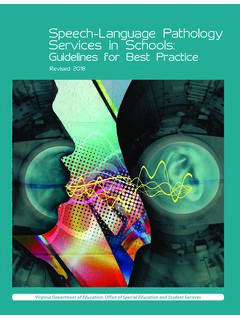Transcription of INNOVATION AND TECHNOLOGY FOR PERSONS WITH …
1 1 INNOVATION AND TECHNOLOGY FOR PERSONS with DISABILITIES Nabil Eid 1. Introduction One of the disabled students at an information TECHNOLOGY (IT) course answered, when asked why he was doing the course, I want to show the world that, though it may be true that I am disabled, I am not disqualified. Disabled but not disqualified this is the motto under which governments, organizations, non governmental organizations (NGOs) and private sectors are working together to enable PERSONS with disabilities (PwDs) to become integrated into mainstream society so that they may realize their full potential. with the advent of information and communications TECHNOLOGY (ICT), new hopes are emerging for PwDs. Despite the huge challenges, sincere efforts are being undertaken to implement the use of ICT to counter obstacles related to disability.
2 The information society represents at once significant opportunities but also potential new barriers for the social inclusion of disabled people. Information and communications TECHNOLOGY and assistive TECHNOLOGY offer new opportunities for everyone, but these opportunities are specifically more significant for PwDs, who use assistive TECHNOLOGY for their daily activities to a higher extent than people in general. Today s assistive TECHNOLOGY , which is adapted to everyone s abilities, means that disabled end users are able to participate in all aspects of social life on more equal terms than ever before. It is vital that people are able to benefit on an equal basis from the rapid development of ICT, to enable them to partake in an inclusive and barrier free information society. 2. A Journey of a Thousand Miles Begins with a Single Step We need information and knowledge in order to meet our basic needs, make decisions, move around, and participate in social, economic and cultural activities.
3 ICT is of course an Nabil Eid is the Executive Secretary of KN4DC project, UN ESCWA, Chairman of Studies Center for Handicapped Research and Consultant in ICT for inclusion and development PwDs in MENA region 2 enabling TECHNOLOGY and we should not lose sight of this fact. If it is not properly planned, managed and implemented, it might throw us into social gaps or the digital divide. The use of ICT in the field of e learning and education is very high on the political agendas of Arab countries, with considerable efforts made at national, regional and global levels to address the special requirements of PERSONS with disabilities, including appropriate educational, administrative and legislative measures to ensure their full inclusion. One of the opportunities for connecting these students is through information communication technologies and assistive TECHNOLOGY (ICT and AT).
4 ICT and AT for the development of disabled PERSONS involve adopting appropriate techniques to obtain maximum benefit. In addition, the use of assistive TECHNOLOGY (AT) can increase disabled PERSONS capabilities and independence both in and out of school settings. The technologies can be used for communication and productivity ends, or to provide an individual with an opportunity to experience recreational opportunities. Individuals with serious sensory disabilities such as physical disabilities, visual impairments or deafness have benefited more than any other group of individuals from advances in assistive technologies. The advances in TECHNOLOGY for these individuals can lead to increased productivity, employment and recreation opportunities. Although some progress has been made towards disability inclusive development, there have been very few initiatives aimed at including disability in the Millennium Development Goals (MDGs) Education for All.
5 New teaching methodologies for PERSONS with disabilities include information communication technologies and assistive TECHNOLOGY (ICT and AT). No pencils, copybooks or books for teaching students with Now it s all ICT and AT! ICT has the potential to make significant improvements in inclusion, development, e learning and education for students with disabilities. 3. Statistics and Factsheet On average, around 10 percent of the world population is disabled and this number is likely to increase in the near future due to various factors, according to the World Health Organization (WHO). Eighty percent of PERSONS with disabilities live in developing countries, according to the UN Development Program (UNDP). Disability rates are significantly higher among groups with lower educational attainment in the countries of the Organization for Economic Cooperation and Development (OECD), according to the OECD Secretariat.
6 On average, 19 percent of less educated people have disabilities, compared to 11 percent among the better educated. 3 The World Bank estimates that 20 percent of the world's poorest people have some form of disability, and tend to be regarded in their own communities as the most disadvantaged. Ninety percent of children with disabilities in developing countries do not attend school, according to the United Nations Educational, Scientific and Cultural Organization (UNESCO). The global literacy rate for adults with disabilities is as low as 3 percent, and 1 percent for women with disabilities, according to a 1998 UNDP study. Despite these challenges, ICT and AT have the potential to make significant improvements to the lives of students, promoting equality and fostering the development of students with disabilities. Including these students in the use of ICT and AT improves their social skills, learning and ultimately their employment opportunities, by providing the best education possible, building their capacities and developing important life skills.
7 4. Overall Goal(s) of Empowering PERSONS with Disabilities through TECHNOLOGY Information and communications TECHNOLOGY (ICT) has been identified as an important aspect of the wider strategy for the social inclusion of students with disabilities. The following are some of the common approaches utilized: Distance e Learning The distance learning home is accessible to students with disabilities. Distance courses allow students with disabilities to continue living at home while they are studying, to share documents, lessons, exchange ideas and make presentations. Using a computer is a common component of the training and studying process. Reading digital and audio libraries Students with intellectual, hearing or reading disabilities, impaired sight, dyslexia and other disabilities are now able to follow educational courses via digital and audio libraries, accessing their material, content and resources via the Internet.
8 Students can connect from home and read or hear the relevant books, without having to go to the local university or library. 4. 3. Internet, broadband for PERSONS with disabilities People with disabilities are today using the Internet, which builds their capacity to communicate with each other at a distance. Using the Internet helps them to gather and understand public information and news, to participate in leisure interests with others, to chat, shop, manage their finances, and write to authorities and friends. A computer with a 4 broadband connection provides opportunities for improved participation in everyday life and independent living. Winning communication PERSONS with disabilities are now able to communicate with others online, taking e learning courses and interacting with the instructor and other students through online discussion forums.
9 Since learners often find it hard to manage synchronous communication, they may experience problems working on the many elements active simultaneously during an online course. The moderator or facilitator of the course will therefore ensure that all learners understand and act on the information presented. The moderator will also monitor the relationship between what is happening on screen, what the presenter may be saying, and what is appearing in print. In the case of online discussion for learners who are deaf, for example, participation in audio conferences or video conferences will not be possible. Another example is online discussion for learners with mobility impairments; these students can make use of an alternative keyboard or speech input software to access the online course and participate in written communication.
10 In Arab countries, we are lacking moderators for synchronous communication in education and e learning on these websites. Access points for PERSONS with disabilities in disadvantaged communities include ICT telecenters and AT centers. These centers, particularly abundant in the Middle East and North Africa (MENA) region, maximize the use of IT skills for the welfare of disabled students in rural and disadvantaged communities. They also promote public awareness of the fact that PwDs can be fully operational and work proficiently in society by using adaptive TECHNOLOGY . But the key question is how many assistive TECHNOLOGY centers are there in Arab regions? I feel that the number is very limited. 5. Empowerment of the Target Group The approach used by ICT and AT for developing students with disabilities is to adopt feasible techniques to attain maximum benefit from the use of ICT for students.



















